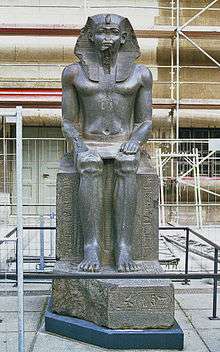Amenemhat II
- See Amenemhat, for other individuals with this name.
| Amenemhat II | |||||||||||||||||||||||||||||||||||||||||||||||||||||||||||||||||||||||||||||||||||||||||||||
|---|---|---|---|---|---|---|---|---|---|---|---|---|---|---|---|---|---|---|---|---|---|---|---|---|---|---|---|---|---|---|---|---|---|---|---|---|---|---|---|---|---|---|---|---|---|---|---|---|---|---|---|---|---|---|---|---|---|---|---|---|---|---|---|---|---|---|---|---|---|---|---|---|---|---|---|---|---|---|---|---|---|---|---|---|---|---|---|---|---|---|---|---|---|
| Ammenemes | |||||||||||||||||||||||||||||||||||||||||||||||||||||||||||||||||||||||||||||||||||||||||||||
 Sitting statue of Amenemhat II, later usurped by 19th Dynasty pharaohs. Berlin, Pergamon Museum | |||||||||||||||||||||||||||||||||||||||||||||||||||||||||||||||||||||||||||||||||||||||||||||
| Pharaoh | |||||||||||||||||||||||||||||||||||||||||||||||||||||||||||||||||||||||||||||||||||||||||||||
| Reign | 1929–1895 BC (12th dynasty) | ||||||||||||||||||||||||||||||||||||||||||||||||||||||||||||||||||||||||||||||||||||||||||||
| Predecessor | Senusret I | ||||||||||||||||||||||||||||||||||||||||||||||||||||||||||||||||||||||||||||||||||||||||||||
| Successor | Senusret II | ||||||||||||||||||||||||||||||||||||||||||||||||||||||||||||||||||||||||||||||||||||||||||||
| |||||||||||||||||||||||||||||||||||||||||||||||||||||||||||||||||||||||||||||||||||||||||||||
| Children | Senusret II, Khenemetneferhedjet I, Ita, Itakayet, Itaweret, Khnemet, Neferet, Sithathormerit, Amenemhatankh (?) | ||||||||||||||||||||||||||||||||||||||||||||||||||||||||||||||||||||||||||||||||||||||||||||
| Father | Senusret I | ||||||||||||||||||||||||||||||||||||||||||||||||||||||||||||||||||||||||||||||||||||||||||||
| Mother | Neferu III | ||||||||||||||||||||||||||||||||||||||||||||||||||||||||||||||||||||||||||||||||||||||||||||
| Died | 1895 BC | ||||||||||||||||||||||||||||||||||||||||||||||||||||||||||||||||||||||||||||||||||||||||||||
| Burial | White Pyramid | ||||||||||||||||||||||||||||||||||||||||||||||||||||||||||||||||||||||||||||||||||||||||||||
Nubkaure Amenemhat II was the third pharaoh of the Twelfth Dynasty of Ancient Egypt, born to Senusret I and his chief wife, Queen Neferu. Little is known of his 34-year reign, which began in 1929 BCE, not even the name of his queen.[1] His throne name, Nubkaure, means "Golden are the Souls of Re."[2]
Reign
The most important record of his reign is on fragments of an annal stone from Memphis (later reused in the New Kingdom). It chronicles his early years, including his donations to various temples, Nubians from Kush coming to pay tribute, a campaign to Syria and the destruction of two cities. Amenemhat II established a coregency with his son Senusret II in his 33rd regnal year, to secure the continuity of the royal succession.
His White Pyramid was constructed at Dahshur. Several royal women were entombed beside it, some with golden jewellery. Four tombs (three royal) remained undisturbed until 1894/5 CE, when they were found by Jacques de Morgan.[3]
Amenemhat's court is little known. Senusret and Ameny were the viziers early in his reign. Two treasurers are known: Merykau and Zaaset. The overseer of the gateway, Khentykhetywer, is known from a stela, where he reported an expedition to the Land of Punt.
Succession

Amenemhat II and his son, Senusret II, shared a brief coregency, the last one of the Middle Kingdom, as far as historians are certain. The stela of Hapu at Aswan dates to the 3rd year of Senusret II and to the 35th year of Amenemhat, meaning that Senusret was crowned in his father's 33rd regnal year.[4]
Sphinx theory

Ludwig Borchardt suggested the eye-paint cosmetics seen on the Great Sphinx were not seen before the 6th Dynasty (making the academic consensus that it represents Khafra unlikely) and noted the pleated stripes on the statue's nemes are grouped in three, a style seen exclusively from the 12th Dynasty. The same stripes, eye-paint, and facial structure are present on Amenemhat's sphinx statue in the Louvre. Author Robert K. G. Temple concluded by this evidence that the Sphinx was created during or before the 4th Dynasty, the original face was damaged beyond repair and Amenemhat II carved his own likeness into the existing head and neck to save the structure (which may explain why the head today is disproportionately small).[5]
References
- ↑ Peter Clayton, Chronicle of the Pharaohs, Thames & Hudson Ltd, (1994), p.81
- ↑ Clayton, p.78
- ↑ Untitled information on White Pyramid burials
- ↑ Murnane, William J. Ancient Egyptian Coregencies, Studies in Ancient Oriental Civilization (SAOC) 40. p.7. The Oriental Institute of the University of Chicago, 1977.
- ↑ Temple, Robert. "The Sphinx Mystery: The Forgotten Origins of the Sanctuary of Anubis". Inner Traditions., 2009, p. 175-195
Further reading
- W. Grajetzki, The Middle Kingdom of Ancient Egypt: History,Archaeology and Society, Duckworth, London 2006 ISBN 0-7156-3435-6, 45-48
External links
| Wikimedia Commons has media related to Amenemhat II. |
- Amenemhat (II) Nubkaure (1914-1879/76 BCE)
- Ancient-Egypt.org
- One likely statue of Amenemhat (II) in 3D model on Sketchfab
|
